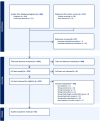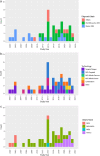The diagnostic accuracy of ultrasound and genomic tests for the diagnosis of autosomal-dominant polycystic kidney disease: a systematic mapping review
- PMID: 40697969
- PMCID: PMC12280278
- DOI: 10.1093/ckj/sfaf187
The diagnostic accuracy of ultrasound and genomic tests for the diagnosis of autosomal-dominant polycystic kidney disease: a systematic mapping review
Abstract
Background: Genomic and ultrasound tests can provide diagnostic and prognostic information on autosomal-dominant polycystic kidney disease (ADPKD), and can screen first-degree relatives in whom early diagnosis can be advantageous. We conducted a systematic mapping review on test accuracy and characteristics over time.
Methods: Medline, Embase, and Cochrane were searched (August 2023) for studies in first-degree relatives/individuals clinically diagnosed with ADPKD receiving genomic or ultrasound tests. Acceptable reference standards for sensitivity/detection rate and specificity were definitive imaging or genomic confirmation. Genomic studies were categorized by technology and read length. Relationships between sensitivity, specificity, genomic technology, diagnostic criteria/reference standard, and genes tested were compared.
Results: From 1029 non-duplicate titles retrieved, 51 genomic and 7 ultrasound studies were included. There were no genomic studies in first-degree relatives. Among studies in patients with clinical diagnoses, genomic sequencing methodologies were highly heterogeneous [next generation (short read (n = 20), long read (n = 1)), targeted Sanger (n = 19), whole exome (n = 1) with additional multi-ligation probe analysis (n = 13)]. Median sensitivity was 78% (Interquartile range 65% to 88%). Ultrasound sensitivity and specificity generally improved with age and were worse in PKD2 patients compared to PKD1 (lowest reported 31% and 88%, respectively, in polycystic kidney disease (PKD) 2 patients aged 5-14; highest 100% and 100%, respectively, in multiple gene/age categories).
Conclusions: Despite technological advances, sensitivity of genomic tests appeared static between 2000 and 2023. Possible explanations include clinical diagnostic criteria (and hence populations recruited) widening from PKD1 to include PKD2 and atypical phenotypes, and small incremental gains of testing genes other than PKD1 and PKD2. For people at risk of ADPKD in genetically unresolved families, the accuracy of ultrasound is uncertain. Unified genomic test taxonomies would facilitate future reviews. Registration: PROSPERO CRD42023456727.
Keywords: ADPKD; detection rate; diagnosis; genomic tests; ultrasonography.
© The Author(s) 2025. Published by Oxford University Press on behalf of the ERA.
Conflict of interest statement
None of the authors have any conflicts to declare.
Figures






Similar articles
-
Contrast-enhanced ultrasound using SonoVue® (sulphur hexafluoride microbubbles) compared with contrast-enhanced computed tomography and contrast-enhanced magnetic resonance imaging for the characterisation of focal liver lesions and detection of liver metastases: a systematic review and cost-effectiveness analysis.Health Technol Assess. 2013 Apr;17(16):1-243. doi: 10.3310/hta17160. Health Technol Assess. 2013. PMID: 23611316 Free PMC article.
-
Elucigene FH20 and LIPOchip for the diagnosis of familial hypercholesterolaemia: a systematic review and economic evaluation.Health Technol Assess. 2012;16(17):1-266. doi: 10.3310/hta16170. Health Technol Assess. 2012. PMID: 22469073 Free PMC article.
-
Antibody tests for identification of current and past infection with SARS-CoV-2.Cochrane Database Syst Rev. 2022 Nov 17;11(11):CD013652. doi: 10.1002/14651858.CD013652.pub2. Cochrane Database Syst Rev. 2022. PMID: 36394900 Free PMC article.
-
Transabdominal ultrasound and endoscopic ultrasound for diagnosis of gallbladder polyps.Cochrane Database Syst Rev. 2018 Aug 15;8(8):CD012233. doi: 10.1002/14651858.CD012233.pub2. Cochrane Database Syst Rev. 2018. PMID: 30109701 Free PMC article.
-
Imaging modalities for the non-invasive diagnosis of endometriosis.Cochrane Database Syst Rev. 2016 Feb 26;2(2):CD009591. doi: 10.1002/14651858.CD009591.pub2. Cochrane Database Syst Rev. 2016. PMID: 26919512 Free PMC article.
References
-
- Mahboob M, Rout P, Leslie SW et al. Autosomal Dominant Polycystic Kidney Disease. Treasure Island, FL, USA: StatPearls Publishing. (date last accessed 7 August 2024), https://www.ncbi.nlm.nih.gov/books/NBK532934/ - PubMed
-
- Brosnahan GM. Volume progression in polycystic kidney disease. N Engl J Med 2006;355:733–4. - PubMed
LinkOut - more resources
Full Text Sources
Miscellaneous

